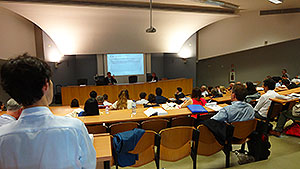Top>Research>Issues in Legal Diversity from the Perspective of Multiculturalism and Legal Pluralism
 Index
Index
Issues in Legal Diversity from the Perspective of Multiculturalism and Legal Pluralism
Fumihiko Ishiyama
Professor, Faculty of Law, Chuo University
Areas of Specialization: Philosophy of Law (particularly contemporary theories of justice with a focus on multiculturalism)
1. Introduction

Legal pluralism session at the IVR 28th World Congress
Report No. 1 has already discussed an overview of the research project entitled “Comprehensive Analysis on Diversity of Legal Systems in Asia-Pacific Region and Convergence towards Establishment of the Rule of Law.” As stated in that report, “there are an infinite number of issues surrounding legal diversity.” In this article, I will put this Research Project in a wider context by explaining approaches of multiculturalism and legal pluralism that are attracting attention in the fields of philosophy, and sociology, of law.
2. Diversity and convergence in domestic law
If, as implied by the phrase “legal culture,” law is a manifestation of culture, then legal diversity must be a manifestation of cultural diversity. In today’s world, we experience cultural diversity in various situations. Through that experience, we can recognize legal diversity as well.
For example, the acceptance of immigrants forces us to deal with cultural differences. When a culture comes across other cultures, there is sometimes friction and clashes as seen in the head scarf issue that flared up in France. On the other hand, there is a considerable chance that interacting cultures can affect each other to bring about peaceful coexistence or amalgamation. Indeed, the latter situation is preferable. But, is it better to blend the culture brought by immigrants with the existing culture of a society, or is it better for the cultures to coexist separately? Multiculturalism stands for the principle that coexistence of multiple cultures is preferable. If so, to what extent can and should the accepting society allow different cultures? The head scarf issue in France grew to the extent of considering legal restrictions on dress, but the issue has to be settled one way or another. So, which way should we take? This illustrates issues surrounding legal diversity and convergence.
Generally speaking, contact among multiple cultures occurs due to the movement of people, goods, and information. However, the history of this movement dates back to ancient times, so it is nearly impossible in today’s world to discover a society with a completely homogeneous culture. Accordingly, assuming that law is a manifestation of culture, domestic law itself contains diversity in many cases. We have to say that the assumption that uniform legal order exists within a certain country is hard to be maintained, even as a conceptual model.
3. Coexistence of Western law and non-Western law

University of Lisbon (site of the IVR 28th World Congress)
In addition to the multiculturalism discussed above, legal pluralism is another approach in the fields of philosophy /sociology of law that focuses on legal diversity. Initially, legal pluralism focused on coexistence of Western law and non-Western law within a country. The example of how an Islamic legal system and a British legal system coexist in Palestine was introduced at a recent international conference[1]. Currently, in many countries which were once colonized, the imperial law and local law have not been merged, but still exist separately. In these countries, multiple legal systems coexist while compromising with each other.
In addition to the case of former colonies on which a different legal system was imposed, the coexistence of Western law and non-Western law is also found in countries which have actively introduced Western law. The number of such countries increases dramatically when expanding our discussion to include the level of customs /social norms in addition to the level of statutory /case law. Japan, with the history of introducing Western law, is a good example.
4. Coexistence of law in other contexts
Today, in addition to the coexistence of Western law and non-Western law, legal pluralism also focuses on phenomena which do not match the concept of uniform legal order.
Allow me to introduce another example raised at the aforementioned conference. In India, the constitution was established with the goal of implementing a unified civil code. However, a unified code does not exist in the field of family law that regulates marriage and succession. Instead, different laws are applied depending on the religion of the parties involved. One problem that can arise in such circumstances is when a member of a family changes religion. For example, in India, polygamy is only permitted for Muslim men. Now, let us assume that a man who was of Hindu faith when he married changes his religion to Islam. Is he now able to marry another wife? The Court ruled that a man cannot marry another wife unless he dissolves his former marriage in accordance with requirements of Hindu law. Although it would seem reasonable to assume that a man would be subject to Islamic law after changing his religion, the Court ruled that Hindu law would remain in effect until he dissolves his former marriage. (Consequently, if the man married another wife, the crime of bigamy could apply.) Today, Courts in India are currently accumulating experience of individual decisions such as this one in the field of family law.
Generally speaking, when multiple legal systems coexist, there is the problem of reaching a compromise between those systems. This is shown by the need to determine which of the contrasting rules to apply in certain situations. The fact that the example discussed above is similar to the issue of international marriage shows how international private law immediately comes to mind as a field of positive law that has handled such problems. The issue of legal diversity and convergence in international transactions which is a theme of the Research Project also belongs to this field.
However, as already illustrated in this article, the need to determine application of contrasting laws is not an issue arising only between different countries. Moreover, the same situation can occur in public law as well as in private law. For example, in the field of tax law, preventing double taxation is just as important as preventing tax avoidance through methods such as tax havens. For this reason, adjustments between taxing bodies are required and are being made. Even in the field of criminal law, preventing double punishment is an issue in addition to preventing the flight of criminals to safe regions.
In this way, issues surrounding legal diversity and convergence exist on both a global and domestic level, and in both private law and public law. Is it best to maintain and expand this legal diversity, or should it be reduced? The answer will depend on the legal field. Generally speaking, in fields which require technical processing, uniformity is preferable to diversity. Nevertheless, when assuming, in spite of any difference among legal fields, that law is a manifestation of culture, there is no easy answer to the question of which uniformity to prefer.
5. Coexistence of state law and non-state law
Currently, legal pluralism is giving the greatest focus to non-state law. In conjunction with globalization, the activities of non-governmental bodies can have almost the same significant effect on individuals as that of governmental bodies. One example is ICANN (The Internet Corporation for Assigned Names and Numbers) which manages internet domains. Consequently, activity regulations and rules of these non-governmental bodies are being recognized as law (non-state law) and inquiries are being made on legal theory which incorporates non-state law as well as state law.
Non-state law exists in a variety of fields. Some familiar examples which are relatively easy to discuss are rules established by the International Olympic Committee and ISO standards related to environmental issues. Further examples of non-state law are lex mercatoria in commercial transactions and voluntary restraints in international finance. In many cases, autonomous dispute resolution procedures exist. One example of this is the arbitration mechanism introduced in the article “Developing New System for International Commercial Dispute Resolution: Singapore in Focus.” In addition to affecting individuals outside of the scope of state law, non-state law is sometimes incorporated into state law and applied in state courts. In this respect, non-state law coexists while interacting with state law.
How should state law respond to this kind of non-state law? Should the relationship be deepened as state law is affected by non-state law, with unification ultimately occurring? Conversely, should the spread of non-state law be supported and promoted? This is yet another issue of legal diversity and convergence. Indeed, this focus on non-state law is directly related to the fundamental question of legal philosophy—“what is law?”
- ^ 28th World Congress of the International Association for Philosophy of Law and Social Philosophy (IVR: Internationale Vereinigung für Rechts- und Sozialphilosophie). Held in July 2017 in Lisbon. Several sessions on multiculturalism and legal pluralism were held at the conference.
- Fumihiko Ishiyama
Professor, Faculty of Law, Chuo University
Areas of Specialization: Philosophy of Law (particularly contemporary theories of justice with a focus on multiculturalism)
- Fumihiko Ishiyama was born in Tokyo in 1961. He graduated from the University of Tokyo, Faculty of Law, in 1984. He completed the Master’s Program in the University of Tokyo, Graduate Schools for Law and Politics, in 1986.
He completed the Doctoral Program in the University of Tokyo, Graduate Schools for Law and Politics, in 1991. Doctor of Law (University of Tokyo).
After serving as a Full-time Lecturer, Assistant Professor and Professor at Daito Bunka University, he assumed his current position in 2009.
His current research themes include the value of cultural diversity in global justice.
His main written works and theses are listed below.
Will Kymlicka and Multiculturalism as a Theory of Justice (1) to (6), Kokka Gakkai Zassi Vol. 113 Issues 1 & 2, 7 & 8, 11 & 12; Vol. 114 Issues 3 & 4, 9 & 10; Vol. 115 Issues 9 & 10 (2000 to 2002)
The Law at a Critical Point 3—New Visions for Legal Practices (co-written, University of Tokyo Press, 1999) (written for Language Policy and State Neutrality)
Humane Order—The Individual and the Universal in Law (co-written, Bokutakusha, 1987) (written for Reverse Discrimination and the Idea of Equality)
- Research Activities as a Member of Research Fellowship for Young Scientists (DC1), Japan Society for the Promotion of Science (JSPS) Shuma Tsurumi
- Important Factors for Innovation in Payment Services Nobuhiko Sugiura
- Beyond the Concepts of Fellow Citizens and Foreigners— To Achieve SDGs Goal 10 “Reduce Inequality Within and Among Countries” Rika Lee
- Diary of Struggles in Cambodia Fumie Fukuoka
- How Can We Measure Learning Ability?
—Analysis of a Competency Self-Assessment Questionnaire— Yu Saito / Yoko Neha - The Making of the Movie Kirakira Megane









